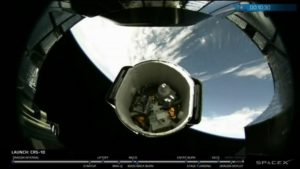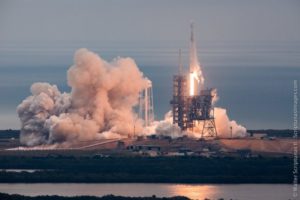SpaceX added another feather to its cap on Sunday, February 19, 2017, when it successfully launched a Falcon 9 rocket for a resupply mission to the International Space Station (ISS) at 9:39 AM local time. The launch was made from NASA’s historic Launch Complex 39A at the Kennedy Space Center at Cape Canaveral in Florida, which has in the past been used for the space agency’s famous Apollo moon missions and several space shuttle flights between 1981 and 2011.
The launch pad was revamped after NASA retired its space shuttle fleet in 2011. More spectacular was the successful landing of the rocket back to land after around eight minutes of the launch, so that it could be utilized for future missions. You can watch the incredible video below:
Initial Launch Aborted Due To Technical Glitch
The launch was initially scheduled for Saturday, February 18, but was called off by SpaceX CEO Elon Musk after a technical anomaly was discovered.
The decision was a wise one, considering the recent spate of mishaps (exploding rockets, failed launches) SpaceX had found itself in. Another accident would have been a total disaster for the company’s future missions with NASA.
The Falcon 9 Rocket Carried A Dragon Capsule With Nearly 2,500 Kg Supplies
The kerosene-fueled two-stage Falcon 9 rocket, standing 213 foot tall (65 meters) and carrying a Dragon cargo freighter with around 2,500 kg of experiments and supplies for the ISS, was launched from the historic launch pad 39 A- the first time that SpaceX was conducting a launch from this site. Pad 39 A, originally built in the 1960s for the Apollo moon program has hosted 12 Saturn 5 blastoffs on test flights, all of NASA’s moon landing missions, as well as the unmanned launch of the space agency’s Skylab space station during 1967-1973.
NASA had launched its space shuttles a total of 82 times between 1981 and 2011, with the last mission taking off in July 8, 2011. The launch pad has remained dormant till then, until SpaceX signed a 20-year lease in 2014 to commercially operate the complex.
‘It was really awesome to see 39A roar back to life for the first time since the shuttle era, and it was extremely special that this first launch off of 39A was a Dragon mission for NASA heading to the space station,’ said Jessica Jensen, a Dragon mission manager.
The resupply mission was the SpaceX’s 10th cargo launch to the space station. The company has around $1.6bn in federal contracts from the US government for resupply missions, as well as several hundred millions more in tie-ups with private companies that aim to deliver satellites into orbit.
What Does The Cargo Actually Include?
According to NASA, the Dragon capsule cargo includes the following-
‘A crystal growth experiment that will crystallize a monoclonal antibody that is undergoing clinical trials for the treatment of immunological diseases. Growing the crystal in space will allow it develop more than it could on Earth where gravity causes crystals to collapse on themselves. Preserving these antibodies in crystals allows researchers a glimpse into how the biological molecules are arranged, which can provide new information about how they work in the body. So far, Earth-grown crystalline suspensions of monoclonal antibodies have proven to be too low-quality to fully model.
Better defining how some bacteria become drug-resistant is the focus of another experiment that aims to develop medicines that counter the resistance. Stem cells like those used to treat strokes and other occurrences also will be studied using experiment supplies brought up on this flight.
The equipment aboard the Dragon includes a major instrument that will survey Earth’s upper atmosphere in a continuation of one of NASA’s longest-running Earth-observing programs. Called SAGE III for Stratospheric Aerosol and Gas Experiment, the instrument examines the levels of ozone, aerosols, nitrogen dioxide and water vapor in the stratosphere and troposphere high above Earth. It is the latest version of an experiment that began in 1979 and has created a multi-decade record of measurements. The 2,200-pound instrument will be connected to the outside of the station to make daily observations for several years.’
Six astronauts- two Americans, three Russians and one Frenchman are currently aboard the station. The capsule is expected to reach the station on Wednesday, following which astronauts Thomas Pesquet of the European Space Agency and Shane Kimbrough of NASA will use the space station’s 57 meter long robotic arm to secure the cargo.
What Next For SpaceX?

SpaceX reportedly plans to launch manned missions to the space station next year from the Kennedy Space Center and from the Cape Canaveral Air Force Station. It also has an ambitious plan for a private, unmanned mission to Mars. Challenges will be aplenty to make every mission a solid success, but one can say that Elon Musk’s grandiose space plans are slowly coming to fruition. The future is bright!














It was really awesome to see 39A roar back to life for the first time since the shuttle era.